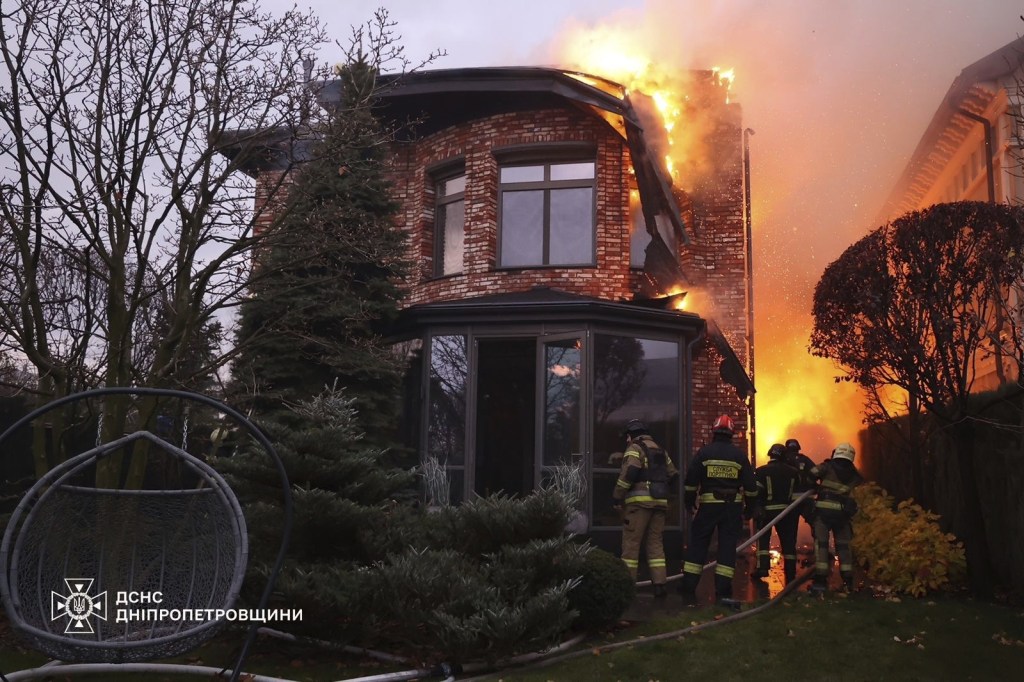
By HANNA ARHIROVA, ILLIA NOVIKOV, AAMER MADHANI and TARA COPP, Associated Press
The Kremlin fired a new intermediate-range ballistic missile at Ukraine on Thursday in response to Kyiv’s use this week of American and British missiles capable of striking deeper into Russia, President Vladimir Putin said.
In a televised address to the country, the Russian president warned that U.S. air defense systems would be powerless to stop the new missile, which he said flies at ten times the speed of sound and which he called the Oreshnik — Russian for hazelnut tree. He also said it could be used to attack any Ukrainian ally whose missiles are used to attack Russia.
“We believe that we have the right to use our weapons against military facilities of the countries that allow to use their weapons against our facilities,” Putin said in his first comments since President Joe Biden gave Ukraine the green light this month to use U.S. ATACMS missiles to strike at limited targets inside Russia.
Pentagon deputy press secretary Sabrina Singh confirmed that Russia’s missile was a new, experimental type of intermediate range missile based on it’s RS-26 Rubezh intercontinental ballistic missile.
“This was new type of lethal capability that was deployed on the battlefield, so that was certainly of concern,” Singh said, noting that the missile could carry either conventional or nuclear warheads. The U.S. was notified ahead of the launch through nuclear risk reduction channels, she said.
The attack on the central Ukrainian city of Dnipro came in response to Kyiv’s use of longer-range U.S. and British missiles in strikes Tuesday and Wednesday on southern Russia, Putin said. Those strikes caused a fire at an ammunition depot in Russia’s Bryansk region and killed and wounded some security services personnel in the Kursk region, he said.
“In the event of an escalation of aggressive actions, we will respond decisively and in kind,” the Russian president said, adding that Western leaders who are hatching plans to use their forces against Moscow should “seriously think about this.”
Putin said the Oreshnik fired Thursday struck a well-known missile factory in Dnipro. He also said Russia would issue advance warnings if it launches more strikes with the Oreshnik against Ukraine to allow civilians to evacuate to safety — something Moscow hasn’t done before previous aerial attacks.
Kremlin spokesman Dmitry Peskov initially said Russia hadn’t warned the U.S. about the coming launch of the new missile, noting that it wasn’t obligated to do so. But he later changed tack and said Moscow did issue a warning 30 minutes before the launch.
Putin’s announcement came hours after Ukraine claimed that Russia had used an intercontinental ballistic missile in the Dnipro attack, which wounded two people and damaged an industrial facility and rehabilitation center for people with disabilities, according to local officials. But American officials said an initial U.S. assessment indicated the strike was carried out with an intermediate-range ballistic missile.
Ukrainian President Volodymyr Zelenskyy said in a Telegram post that the use of the missile was an “obvious and serious escalation in the scale and brutality of this war, a cynical violation of the UN Charter.”
He also said there had been “no strong global reaction” to the use of the missile, which he said could threaten other countries.
“Putin is very sensitive to this. He is testing you, dear partners,” Zelenskyy wrote. “If there is no tough response to Russia’s actions, it means they see that such actions are possible.”
The attack comes during a week of escalating tensions, as the U.S. eased restrictions on Ukraine’s use of American-made longer-range missiles inside Russia and Putin lowered the threshold for launching nuclear weapons.
The Ukrainian air force said in a statement that the Dnipro attack was launched from Russia’s Astrakhan region, on the Caspian Sea.
“Today, our crazy neighbor once again showed what he really is,” Zelenskyy said hours before Putin’s address. “And how afraid he is.”
Russia was sending a message by attacking Ukraine with an intermediate-range ballistic missile capable of releasing multiple warheads at extremely high speeds, even if they are less accurate than cruise missiles or short-range ballistic missiles, said Matthew Savill, director of military sciences at the Royal United Services Institute, a London-based think tank.
“Why might you use it therefore?” Savill said. “Signaling — signaling to the Ukrainians. We’ve got stuff that outrages you. But really signaling to the West ‘We’re happy to enter into a competition around intermediate range ballistic missiles. P.S.: These could be nuclear tipped. Do you really want to take that risk?’”
Military experts say that modern ICBMs and IRBMs are extremely difficult to intercept, although Ukraine has previously claimed to have stopped some other weapons that Russia described as “unstoppable,” including the air-launched Kinzhal hypersonic missile.
David Albright, of the Washington-based think tank the Institute for Science and International Security, said he was “skeptical” of Putin’s claim, adding that Russian technology sometimes “falls short.”
He suggested Putin was “taunting the West to try to shoot it down … like a braggart boasting, taunting his enemy.”
Earlier this week, the Biden administration authorized Ukraine to use the U.S.-supplied, longer-range missiles to strike deeper inside Russia — a move that drew an angry response from Moscow.
Days later, Ukraine fired several of the missiles into Russia, according to the Kremlin. The same day, Putin signed a new doctrine that allows for a potential nuclear response even to a conventional attack on Russia by any nation that is supported by a nuclear power.
The doctrine is formulated broadly to avoid a firm commitment to use nuclear weapons. In response, Western countries, including the U.S., said Russia has used irresponsible nuclear rhetoric and behavior throughout the war to intimidate Ukraine and other nations.
White House press secretary Karine Jean-Pierre said Thursday that Russia’s formal lowering of the threshold for nuclear weapons use did not prompt any changes in U.S. doctrine.
She pushed back on concerns that the decision to allow Ukraine to use Western missiles to strike deeper inside Russia might escalate the war.
″They’re the ones who are escalating this,” she said of the Kremlin — in part because of a flood of North Korean troops sent to the region.
More than 1,000 days into war, Russia has the upper hand, with its larger army advancing in Donetsk and Ukrainian civilians suffering from relentless drone and missile strikes.
Analysts and observers say the loosening of restrictions on Ukraine’s use of Western missiles is unlikely to change the the course of the war, but it puts the Russian army in a more vulnerable position and could complicate the logistics that are crucial in warfare.
Putin has also warned that the move would mean that Russia and NATO are at war.
“It is an important move and it pulls against, undermines the narrative that Putin had been trying to establish that it was fine for Russia to rain down Iranian drones and North Korean missiles on Ukraine but a reckless escalation for Ukraine to use Western-supplied weapons at legitimate targets in Russia,” said Peter Ricketts, a former U.K. national security adviser who now sits in the House of Lords.
Associated Press writers Jill Lawless and Emma Burrows in London, and Zeke Miller and Lolita C. Baldor in Washington contributed to this report.
Originally Published:









